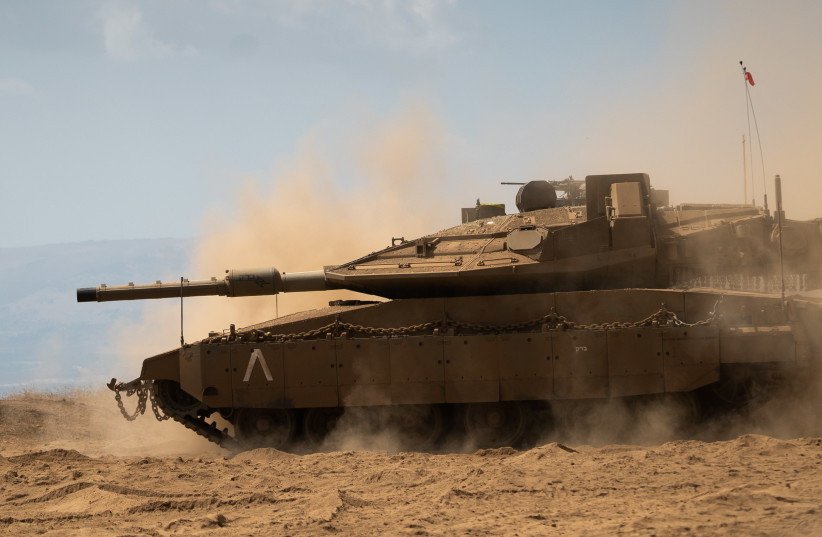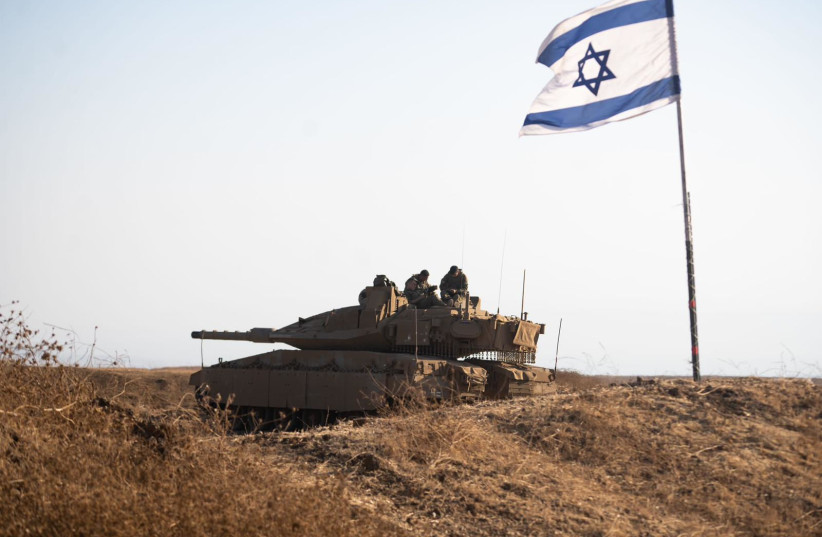Last week Israel unveiled the much anticipated new Barak tank, an updated version of Israel’s successful family of Merkava tanks.
The tank had been in the works for many years, led by Israel’s Defense Ministry’s Tank Administration (MANTAK) and local defense companies from a concept almost a decade ago to planning and testing phases over the last half-decade.
It’s important to revisit some of the technology that underpins the success of this project because it is part of a wider story of Israel’s technological success, both on the battlefield and in other commercial endeavors.
Israel's world-leading super tank
Back in 2017, when we had profiled this same tank project, The Jerusalem Post noted that “the Merkava MK4 Barack is designed as a ‘smart tank’ with dozens of sensors to identify the enemy, and rapid fire closure that allows elimination of the target before it disappears from view.” Over the years as Israel had invested in this project, a lot of new technology matured, whether it is the Trophy active protection system, or various sensors being used.
From the point of view of the Ministry of Defense and IDF, this is the most advanced tank in the world today. That matters, because today Israeli technology is highly sought after.

The world is changing. Conventional wars now loom large, whereas when we look back to the era when the concept of a new tank was envisioned, the world was still heavily invested in counter-insurgency. What that meant was the prevalent usage of small units, special forces, and a lot of hi-tech but not a lot of heavy platforms.
It is not lost on us now, as Israel prepares for the future of warfare, that the 1973 Yom Kippur War was 50 years ago. Indeed, this week there have been many references to that famed conflict. If we look back at that war, Israel faced technological challenges from its enemies. Egypt’s army had Russian-supplied surface-to-air missiles (SAMs) and some of the troops were equipped with Sagger-guided missiles, as well as RPG-7s. Israel had performed well in 1967 using masses of armored vehicles but by 1973, it was not as easy going.
We know now what came of that. Israel’s investment in drones, of which the country was an early pioneer, was one result of challenges faced by the SAM threat, a threat that also appeared with Syrian SAMs in Lebanon. No matter, Israel was able to overrun them in 1982.
But years later in the 2006 war, Israel once again faced threats to armored vehicles and its war-fighting abilities in Lebanon. Years of counter-insurgency in the West Bank perhaps meant forces needed retooling to deal with the kind of threat Hezbollah has. We also know that the Hezbollah rocket threat helped lead to the development of the Iron Dome.
THEREFORE, WHEN we think of the new Barak tank and the technology it has brought to the forefront, it’s worth considering it as part of this history. Wars and the kinds of weapon systems that are put into action are not fought in a vacuum. It is a common refrain that militaries learn to fight the last war, not the next one. In this case, Israel’s technology is trying to anticipate the next one.
How Rafael moulded the new super-tank
Rafael Advanced Defense Systems played a role in this new tank. It’s important to understand in general, that most Israeli large platforms, whether it is a tank or a Sa’ar 6 warship, are a sum of all their parts and in Israel’s world-class defense industry often many platforms play a role.
Niv Cohen, vice-president and head of Maneuverable Systems Directorate at Rafael discussed the company’s contribution. “We enhanced various capabilities for this iteration, notably in terms of situational awareness. During specific operational periods, we honed our system, making it more effective and operationally sound. Over the years, we’ve undertaken numerous upgrades. Recent collaborations with the Israeli Ministry of Defense and other valued customers led to a pivotal realization – by integrating sensors into the Trophy system, we not only detect threats directed at our tanks but also provide a comprehensive battlefield overview to the tank commander and the entire team.”
The protection system covers a wide range of threats from enemy forces and situational awareness of friendly forces. Modern-day battlefields have new types of threats, such as drones. “In our Merkava Mark 4 Barak, we’ve significantly improved the Trophy system’s capabilities. It now furnishes the team with valuable intelligence, making it a critical asset in the field,” Cohen said. Like in the world of smartphones, defense systems have to keep releasing new versions. He points to updated algorithms and software to counter emerging threats on the battlefield. “In summary, the two main areas of improvement in the Merkava Mark 4 Barak revolve around the integration of the Trophy system for enhanced situational awareness and our continuous efforts to stay ahead of evolving threats through regular system updates.”
What is the unique tech featured in the Barak super tank?
To better understand the unique technology that Israel put on its latest tank, I spoke to Idan Tavor, vice president of Combat Vehicles and Robotics at Elbit Systems.
“Elbit Systems is proud of the capabilities developed for MANTAK for the Barak main battle tank, and in particular the tank’s software that was developed on a joint team led by MANTAK and our company under MANTAK’s lead,” Tavor said.
ONE OF the most impressive pieces of technology is the Iron Vision helmet. The helmet borrows from some of the logic behind Air Force helmets and head-up displays, such that the commander now can see a display of what is happening outside the vehicle, while buttoned down in the tank. This intuitive concept gives the commander an instant sense of what is happening, from the safety of the vehicle.
The latest technology also gives them a sense of what matters around the tank. This, along with all the sensors on the tank, provides a unique panoramic view of the operations. This includes the gunner and the commander, who wears the helmet.

The state-of-the-art sensors and sights go along with artificial intelligence for the detection of objects and “fusing” the detection with the optics. “The sights are connected to the fire control system, which we developed and it is the latest, which means the performance and lethality are the best we could provide fire on the move and day and night,” said Tavor.
There is a new user interface with touch screens and the latest software. “Software is one of the main changes in this tank; software is incorporating all the sensors and we have a lot of sensors and situational awareness laid down to users in an intuitive way and low cognitive burden; both on touch screens and the helmet,” says Tavor.
Israel borrows a lot of tech ideas here from what works in the civilian world. Many young people joining the army these days have smartphones and may have experience in gaming. They may know what a virtual reality framing display offers. How do you incorporate that into a 65-ton tank with a cannon that shakes the ground when it fires? Well, you have to do a lot of work to make sure that those using these displays or the helmet are not going to get vertigo or suffer other issues.
THE USER interface is not meant to just be easy to use operationally but also to teach. The goal was to make it accessible – as fast as we can bring people to understand it. That was part of the focus and the software is connected to the C4i Torch system of the IDF and the helmet, like one unified video from cameras with zero latency.
There is also a joystick to control things on the tank. Once again, this borrows from what seems intuitive and comfortable. But it’s more robust than the civilian world. Companies like Rafael and Elbit are supplying technology such as the e-Lynx communication systems and Torch-X application for MANTAK’s Barak vehicle.
What will the tank of the future look like?
Of course, this all points the way to how things might be heading in the world of armored vehicles. First, it shows how technology is just as important as the platform itself. Eventually, tanks won’t need all the operators they had in the past.
This isn’t like the old days, the era of tank battles like Kursk or those around Tobruk are no more. Do tanks need a driver, gunner, commander, and loader such as in the past? Or can some of the operations be unmanned?
There are issues involved. A lot of the new technology that is AI-driven is designed to help sensors identify objects and segregate what is important from what is not important. For instance, determining that a bush is not important, while a person with an RPG is.
If you overburden the user with too much information it doesn’t help, it helps rather to give the user the right information and let them back decisions. At the end of the day, a tank observing an area needs people to be watching at all times to make the decisions even if it can streamline away some physical tasks of the past.
